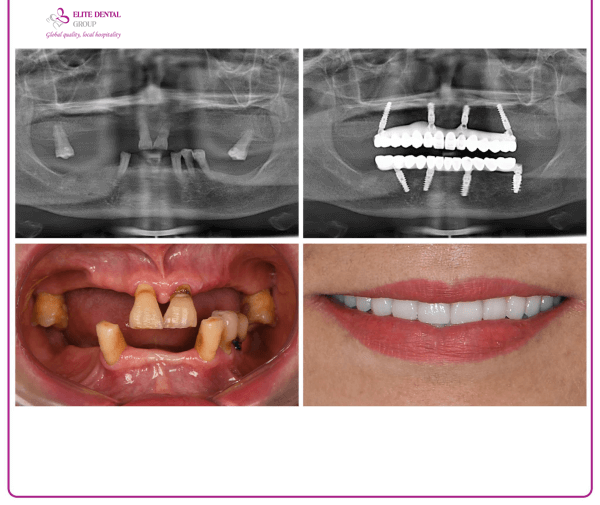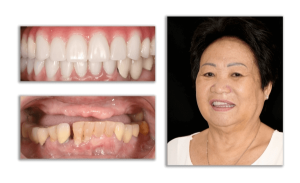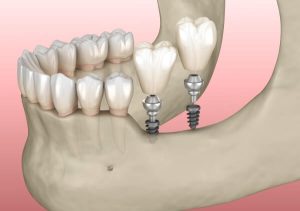Table of content
In the implant dental restoration process, impression taking is a crucial step that significantly impacts the final restoration outcome. So, what is implant impression taking, and what are the available methods? Let’s explore this topic with Elite Dental!
1. What is Implant Impression Taking?
Implant impression taking is a dental technique commonly applied during the implant placement procedure.
The goal of implant impression taking is to create a physical mold of the entire dental arch, along with all necessary technical parameters, to craft precisely sized and accurately fitting crowns.

2. Why is Implant Impression Necessary?
Dental implant procedures are typically divided into two main stages: the surgical placement of the implant into the jawbone and the final restoration of the crown onto the implant. Implant impression taking is the critical first step in the latter phase of crown restoration.
- For single implant cases, the impression is taken during the crown restoration phase.
- For full-arch implant cases, the impression process occurs twice: immediately after surgery to create temporary teeth for the patient and again during the final crown restoration phase (6-9 months post-surgery).
Any errors in the impression-taking process can result in crowns that lack precision and fail to fit snugly onto the implant, potentially causing issues such as gum inflammation, abutment disconnection, or even implant rejection.
Thus, it’s essential to choose a reputable dental clinic with experienced professionals and modern equipment to ensure accurate impressions, minimizing errors and unwanted complications.
When is Implant Impression Performed?
Implant impressions are taken once the implant has fully integrated into the jawbone, marking the beginning of the final crown restoration stage. This is a critical step that affects the crafting of the crown. The integration time varies, typically taking 3–4 weeks for high-end implant brands like Straumann or 2–3 months for other brands.
3. Exploring Implant Impression Taking with Common Methods and Procedures
Currently, there are three popular methods for implant impression taking: dental plaster, 3D scanning technology, and the PIC system. Each method has its own advantages and disadvantages, so let’s explore them in detail.
3.1. Traditional Impression Method
Traditional dental impressions using plaster is a manual method that has been practiced for a long time and is still in use today.
Advantages:
- Simple and easy to perform.
- Materials for taking impressions are easily accessible and cost-effective.
- The impression remains intact without distortion.
Disadvantages:
- Accuracy may be compromised due to gum tissues obscuring the teeth during impression taking.
- Can cause discomfort during the impression process.
- There is a risk of plaster entering the airways.
Process:
Step 1: Pour plaster into a cup, add a small amount of water, and mix thoroughly for about 30-40 seconds.
Step 2: Pour the mixture into the impression tray, being careful not to spill.
Step 3: Place the impression tray into the patient’s mouth and wait for about 5-7 minutes.
Step 4: Continue mixing plaster as in Step 1, then pour it into the tray as in Step 3. Wait for about 1 hour for the plaster to set, and the impression will be ready.
3.2. 3D Scanning Technology for Impressions
At Elite Dental, we use the PrimeScan 3D scanning technology for digital impressions. This advanced method streamlines the process and saves time while waiting for crown fabrication.
Advantages:
- Scans and takes detailed impressions of the teeth surfaces and bite under digital format, creating a 3D model of the dental arch.
- High scan accuracy with Smart Pixel Sensor technology, capable of capturing 10,000,000 3D pixels per second, combined with Dynamic Depth technology measuring up to 20mm.
- The small, compact, and safe scan head provides comfort, avoiding nausea or discomfort during the impression process.

Disadvantages:
This method is only suitable for cases with 1-2 implant posts or when the distance between the implant posts is not too far apart. If the distance between the posts is too large, or in full-arch implant cases, the results may be inaccurate, leading to difficulties in fabrication and potential complications later on.
Process:
Step 1: The dentist uses a scanner to scan the entire dental arch and collects the data in a 3D file format.
Step 2: The 3D image is transferred to specialized software for surface processing. The dentist can make additional adjustments in areas not fully scanned to create a complete image.
Step 3: The dental impression data is sent to the crown fabrication department.
However, this disadvantage can be addressed when you choose treatment at Elite Dental. Our clinic uses the PIC system in addition to 3D scanning technology, which enhances the speed and accuracy of implant scans.
The PIC system (Precise Implant Captures) is an advanced implant impression technique utilizing stereo-optical technology. This system precisely locates the position of the implant posts and is particularly useful for full-arch implants or multiple single implants spaced far apart.
Advantages:
- This is an optimal solution for patients with multiple missing teeth or full-arch edentulism.
- It accurately identifies implant positions down to 4 microns, regardless of the distance between implants.
- The scanning speed is quick, reducing the impression time and providing a more comfortable experience for patients.
- Enhances the passive fit of the bar structure on the implants.
- Temporary restorations can be placed in a single appointment, reducing the restoration time from 24–36 hours to just 2–4 hours.
Disadvantages:
- This is a new impression method that has not yet been widely adopted by many dental clinics.
Process:
Step 1: Scan the implant positions using the PIC system, accurately recording the positions and angles of the implants.
Step 2: Capture the soft tissue with the PrimeScan intraoral scanner.
Step 3: The PIC file containing implant positions is aligned with the soft tissue data in CAD/CAM software to complete the digital model.
With its superior features, the PIC system helps optimize the digital treatment process for implants. Thanks to the PIC system, implant impressions are more comfortable for patients while maintaining high precision. Each implant restoration created with this system achieves a superior passive fit, ensuring a perfect outcome both aesthetically and functionally.
Which Implant Impression Method is Most Effective and Accurate?
The combination of 3D scanning with the PrimeScan intraoral scanner and the PIC system is currently the most effective and accurate implant impression method for single implants, multiple posts, or full-arch implants. With the PIC system, patients can experience a comfortable, gentle impression process without discomfort or nausea, while treatment time is shortened, errors due to waiting time are minimized, and overall safety and effectiveness are ensured.
4. Treatment Experience at Elite Dental: Gentle Implant Impressions, Perfect Smiles with PIC Technology
Elite Dental is the first dental clinic in Vietnam to apply PIC technology. This allows our patients in Vietnam to experience the most advanced dental impression technology available today, significantly reducing treatment time by more than half compared to previous methods, making it more convenient for patients from other provinces or even abroad.
In addition, Elite Dental takes pride in having a team of highly skilled doctors with over 15 years of experience in implantology. Our team is adept at precise impression taking and developing suitable treatment plans. This ensures that patients achieve comprehensive results in both bite function and aesthetics, guaranteeing safety and long-term durability, especially for cases of multiple tooth loss or full-arch edentulism.
A prime example is the case of Ms. X. (nearly 70 years old, Australian expat) who had lost many teeth, and her remaining teeth were loose, causing difficulty in eating and a lack of confidence when interacting with others. At Elite Dental, Ms. X. was recommended for a full-arch implant restoration using the ProArch/All-on-4 method for both upper and lower jaws. After six months, she returned to Elite Dental for the final restoration phase. During this phase, the doctor used the PIC system to take precise impressions, accurately locating the implant posts and minimizing treatment time. This enabled Ms. X. to have a beautifully aligned set of teeth and enjoy better eating comfort.

The information shared above provides useful details about the implant impression method and process. In general, the technique for taking dental impressions continues to improve, offering higher precision and a more comfortable experience for patients. Among these, the PIC system is the most advanced method available today. To learn more about the PIC impression method and our implant services, please contact Elite Dental HERE.
Tips for you: >> What Makes Elite Dental’s Implant Treatment Plan Unique? >> How long does dental implant surgery take and what factors affect it? >> Lost All Your Teeth? Dental Implants vs. Removable Dentures







